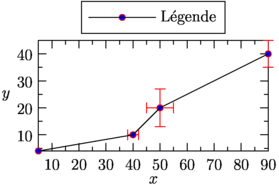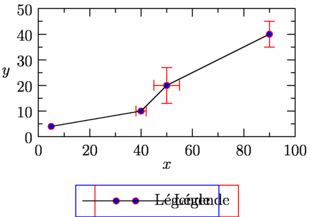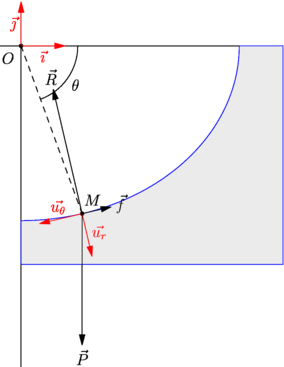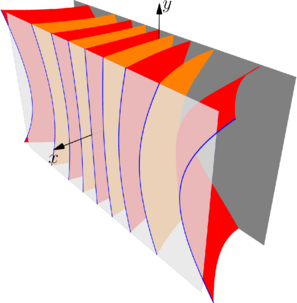

|
// Graphique pour les Sciences, avec barres d'erreur import graph; size(8cm,6cm); pair[] f={(5,4),(40,10),(50,20),(90,40)}; pair[] df={(0,0),(2,0),(5,7),(0,5)}; errorbars(f,df,red); draw(graph(f),"L\'egende", marker(scale(0.8mm)*unitcircle,red,FillDraw(blue),above=false)); legendmargin=5; attach(legend(),point(N),5N); xaxis("$x$",BottomTop,LeftTicks); yaxis("$y$",LeftRight,RightTicks); |


|
// Graphique pour les Sciences, avec barres d'erreur import graph; size(8cm,6cm,IgnoreAspect); pair[] f={(5,4),(40,10),(50,20),(90,40)}; pair[] df={(0,0),(2,0),(5,7),(0,5)}; errorbars(f,df,red); draw(graph(f),"L\'egende", marker(scale(0.8mm)*unitcircle,red,FillDraw(blue),above=false)); xaxis("$x$",BottomTop,LeftTicks); yaxis("$y$",LeftRight,RightTicks); legendmargin=5; attach(legend(),point(S),30S); |


|
// Graphique pour les Sciences, avec barres d'erreur import graph; size(8cm,6cm,IgnoreAspect); pair[] f={(5,4),(40,10),(50,20),(90,40)}; pair[] df={(0,0),(2,0),(5,7),(0,5)}; errorbars(f,df,red); draw(graph(f),"L\'egende", marker(scale(0.8mm)*unitcircle,red,FillDraw(blue),above=false)); scale(true); xaxis("$x$",BottomTop,LeftTicks); yaxis("$y$",LeftRight,RightTicks); legendmargin=5; attach(legend(),point(S),30S); |


|
// Graphique pour les Sciences, avec barres d'erreur import graph; size(8cm,6cm); pair[] f={(5,4),(40,10),(50,20),(90,40)}; pair[] df={(0,0),(2,0),(5,7),(0,5)}; errorbars(f,df,red); draw(graph(f),"L\'egende", marker(scale(0.8mm)*unitcircle,red,FillDraw(blue),above=false)); scale(true); xaxis("$x$",BottomTop,LeftTicks); yaxis("$y$",LeftRight,RightTicks); legendmargin=5; attach(legend(),point(S),30S); |


|
// Graphique pour les Sciences, avec barres d'erreur import graph; size(8cm,6cm); pair[] f={(5,4),(40,10),(50,20),(90,40)}; pair[] df={(0,0),(2,0),(5,7),(0,5)}; errorbars(f,df,red); draw(graph(f),"L\'egende", marker(scale(0.8mm)*unitcircle,red,FillDraw(blue),above=false)); scale(true); xaxis("$x$",BottomTop,LeftTicks); yaxis("$y$",LeftRight,RightTicks); legendmargin=5; pair p1=point(S), p2=truepoint(S); attach(legend(red),(p1.x,p2.y),10S); attach(legend(blue),p2,10S); |


|
// Graphique pour les Sciences, avec barres d'erreur import graph; picture pic; real xsize=8cm, ysize=6cm; size(pic,xsize,ysize,IgnoreAspect); pair[] f={(5,4),(40,10),(50,20),(90,40)}; pair[] df={(0,0),(2,0),(5,7),(0,5)}; errorbars(pic,f,df,red); draw(pic,graph(pic,f),"legend", marker(scale(0.8mm)*unitcircle,red,FillDraw(blue),above=false)); scale(pic,true); xaxis(pic,"$x$",BottomTop,LeftTicks); yaxis(pic,"$y$",LeftRight,RightTicks); legendmargin=5; add(pic,legend(pic),point(pic,NW),20SE,UnFill); picture pic2; size(pic2,xsize,ysize,IgnoreAspect); frame mark; filldraw(mark,scale(0.8mm)*polygon(6),green,green); draw(mark,scale(0.8mm)*cross(6),blue); draw(pic2,graph(pic2,f),marker(mark,markuniform(5))); scale(pic2,true); xaxis(pic2,"$x$",BottomTop,LeftTicks); yaxis(pic2,"$y$",LeftRight,RightTicks); xequals(pic2,60.0,green+Dotted); yequals(pic2,25.0,green+Dotted); add(pic.fit(),(0,0),N); add(pic2.fit(),(0,-.5cm),S); |


|
import geometry; size(7.5cm,0); // Affichage du repère par défaut (O,vec{i},vec_{j}) show(defaultcoordsys); real a=5, b=4, theta=-27, poids=3; ellipse el = ellipse(origin, a, b); arc ar = arc(el,(0,-b),(a,0),CCW); path p = (0,-b-1)--ar--(a+1,0)--(a+1,-b-1)--cycle; point pO = (0,0), pM=angpoint(ar,90+theta); abscissa abscM = nodabscissa(el,pM); real timeM = abscM.x; vector utangM = -dir(el,timeM), unormM = rotate(90)*utangM, vpoids=(0,-poids), vreactionN = -dot(vpoids,unormM)*unormM, vfrottement = -dot(vpoids,utangM)*utangM; filldraw(p,lightgray,blue); draw(pO--pM,dashed); markangle("$\theta$",1.5cm,pM,origin,(1,0)); // Affichage d'un nouveau repère (M,vec{u_{\theta}},vec_{u_{r}}) coordsys R=cartesiansystem(pM,i=utangM,j=unormM); show("$M$", "$\vec{u_{\theta}}$", "$\vec{u_{r}}$", R, xpen=invisible); // Affichage des trois vecteurs dans le repère R point RpM=changecoordsys(R, pM); show(Label("$\vec{f}$",EndPoint),RpM+vfrottement); show(Label("$\vec{R}$",EndPoint),RpM+vreactionN); show(Label("$\vec{P}$",EndPoint),RpM+vpoids); |


|
import geometry; size(7.5cm,0); // Affichage du repère par défaut (O,vec{i},vec_{j}) show(defaultcoordsys); real a=5, b=4, theta=-70, poids=3; ellipse el = ellipse(origin, a, b); arc ar = arc(el,(0,-b),(a,0),CCW); path p = (0,-b-1)--ar--(a+1,0)--(a+1,-b-1)--cycle; point pO = (0,0), pM=angpoint(ar,90+theta); abscissa abscM = nodabscissa(el,pM); real timeM = abscM.x; vector utangM = -dir(el,timeM), unormM = rotate(90)*utangM, vpoids=(0,-poids), vreactionN = -dot(vpoids,unormM)*unormM, vfrottement = -dot(vpoids,utangM)*utangM; filldraw(p,lightgray,blue); draw(pO--pM,dashed); markangle("$\theta$",1.5cm,pM,origin,(1,0)); // Affichage d'un nouveau repère (M,vec{u_{\theta}},vec_{u_{r}}) coordsys R=cartesiansystem(pM,i=utangM,j=unormM); show("$M$", "$\vec{u_{\theta}}$", "$\vec{u_{r}}$", R, xpen=invisible); // Affichage des trois vecteurs dans le repère R point RpM=changecoordsys(R, pM); show(Label("$\vec{f}$",EndPoint),RpM+vfrottement); show(Label("$\vec{R}$",EndPoint),RpM+vreactionN); show(Label("$\vec{P}$",EndPoint),RpM+vpoids); |


|
import graph3; import palette; size(8cm,0); currentprojection=perspective(camera=(5,2,8),up=Y); pen[] couleur={paleblue,white}; real c=1; // demi-distance focale int n=4; // nombre d'hyperboloïdes real vx=2, vy=vx; for(int i=0; i<n; ++i){ real d=(i+1)*c/(n+1); real a=sqrt(c^2-d^2); real f(pair z) {return d*sqrt(abs(z)^2/a^2+1);} surface s=surface(f,(-vx,-vy),(vx,vy),4,4,Spline); draw(s,couleur[i%couleur.length]); draw(rotate(180,X)*s,couleur[i%couleur.length]); real x(real t) {return 2;} real y(real t) {return t;} real z(real t) {return d*sqrt(1+(t^2+vx^2)/a^2);} path3 p=graph(x,y,z,-vy,vy,operator ..); draw(p^^rotate(180,X)*p,red); } path3 pl0=(vx,vy,0)--(vx,-vy,0)--(-vx,-vy,0)--(-vx,vy,0)--cycle; draw(surface(pl0),white); draw((vx,-vy,0)--(vx,vy,0),orange); dot((0,0,c),red); dot((0,0,-c),red); path3 pl=(0,vy+1,1.8vx)--(0,vy+1,-1.8vx) --(0,-vy-1,-1.8vx)--(0,-vy-1,1.8vx)--cycle; surface plan=surface(pl); draw(plan,lightgrey,.8blue); draw(shift(vx,0,0)*plan,lightgrey+opacity(.8),.8blue); limits((-vx-2,-vy-2,-vx),(vx+2,vy+2,vx+3)); xaxis3("$x$",Arrow3); yaxis3("$y$",Arrow3); shipout(bbox(2mm,Fill(white))); |


|
import graph3; import palette; size(8cm); currentprojection=perspective(camera=(5,4,-5),up=Y); currentlight=nolight; pen[] couleur={orange,red}; real c=1; // demi-distance focale int n=4; // nombre d'hyperboloïdes real vx=1.5, vy=vx; for(int i=0; i<n; ++i){ real d=(i+1)*c/(n+1); real a=sqrt(c^2-d^2); real f(pair z) {return d*sqrt(abs(z)^2/a^2+1);} surface s=surface(f,(0,-vy),(vx,vy),4,4,Spline); draw(s,couleur[i%couleur.length]); draw(rotate(180,X)*s,couleur[i%couleur.length]); real x(real t) {return vx;} real y(real t) {return t;} real z(real t) {return d*sqrt(1+(t^2+vx^2)/a^2);} path3 p=graph(x,y,z,-vy,vy,operator ..); draw(p^^rotate(180,X)*p,blue); } path3 pl0=(vx,vy,0)--(vx,-vy,0)--(0,-vy,0)--(0,vy,0)--cycle; draw(surface(pl0),red); draw((vx,-vy,0)--(vx,vy,0),blue); dot((0,0,c),red); dot((0,0,-c),red); path3 pl=(0,vy,1.8vx)--(0,vy,-1.8vx) --(0,-vy,-1.8vx)--(0,-vy,1.8vx)--cycle; surface plan=surface(pl); draw(plan,grey); draw(shift(vx,0,0)*plan,lightgrey+opacity(.8),.8blue); limits((-.5vx,-1.5vy,-vx),(1.5vx,1.3vy,vx)); xaxis3("$x$",Arrow3); yaxis3("$y$",Arrow3); |
Dernière modification le Fri Dec 30 17:33:28 CET 2011 par G.Marris Valide XHTML